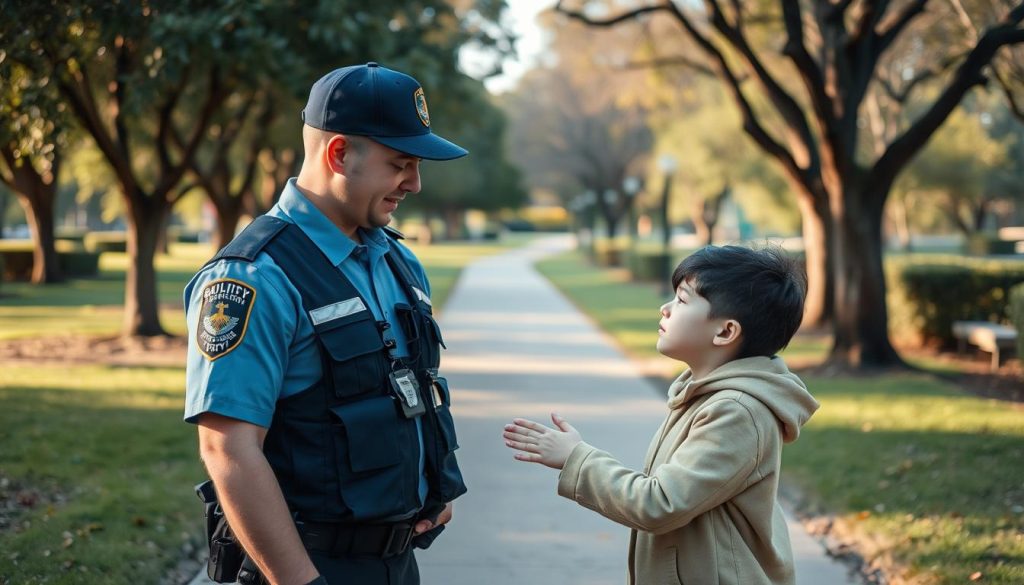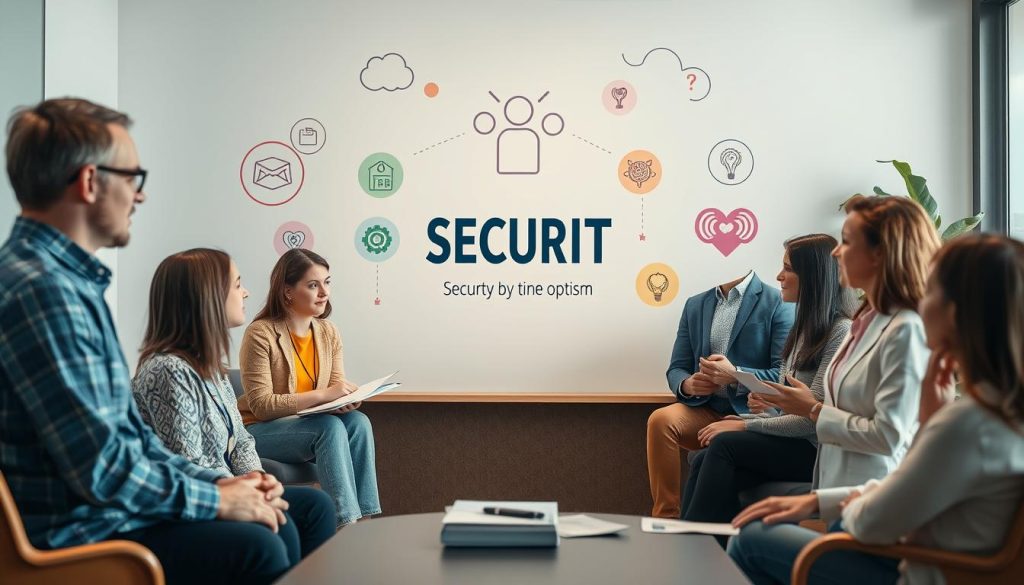Safety is very important for families of people with autism. This guide looks at the special security needs of those with autism. We’ll see if they need dedicated security guards and what other support is out there.
We’ll talk about everything from professional care attendants to specialized security. Our aim is to give you useful info. This will help you make smart choices about security and support for your loved ones with autism.
Understanding Security Needs for Individuals with Autism
People with autism face special safety challenges. These come from their sensory sensitivity and trouble with communication. We’ll look at what safety needs they have and how these affect their daily lives.
Unique Safety Challenges in Autism Spectrum Disorder
Those with autism may have behavioral challenges that risk their safety. These can include wandering, not seeing danger, and hard social interactions. It’s important to pay close attention to these behaviors to keep them safe.
Risk Assessment for Autistic Individuals
Assessing risks for people with autism means looking at their specific needs and weaknesses. This includes how well they can talk, handle social situations, and react in emergencies. A detailed risk assessment helps make safety plans that fit each person’s unique situation.
Common Security Concerns from Families
Families of people with autism often worry about their safety. Their main concerns are:
- Wandering and elopement
- Interactions with law enforcement
- Bullying or exploitation
- Managing sensory overload in public spaces
| Security Concern | Impact on Individuals with Autism | Potential Solutions |
|---|---|---|
| Wandering | Risk of getting lost or injured | GPS tracking devices, ID bracelets |
| Sensory Overload | Anxiety, meltdowns in public | Noise-cancelling headphones, quiet spaces |
| Communication Barriers | Difficulty expressing needs or emergencies | Communication cards, speech devices |
Do People With Autism Have Security Guards

People with autism usually don’t have their own security guards. Instead, they get help from personal care attendants or special support staff. These helpers offer services that fit each person’s needs.
Whether someone with autism needs a security guard depends on several things. This includes how severe their autism is, their behaviors, and any safety risks. Sometimes, families choose to hire security if they feel it’s really necessary.
Here’s a look at the support options for those with autism:
| Support Type | Primary Focus | Typical Duties |
|---|---|---|
| Personal Care Attendants | Daily living assistance | Hygiene, meal prep, medication management |
| Behavioral Support Staff | Behavior management | Implementing behavior plans, crisis intervention |
| Trained Security Specialists | Safety and protection | Risk assessment, emergency response, public interactions |
Even though security guards aren’t usual, many families focus on making safe spaces. They use a mix of professional help, changes to the environment, and technology. This way, they keep their loved ones with autism safe and happy.
Types of Support Personnel Available for Autism Care
Autism care needs special support to meet unique needs. Many professionals play key roles in giving full care and keeping individuals with autism safe.
Professional Care Attendants
Personal care attendants help with daily tasks. They assist with hygiene, meals, and managing medicine. They also offer emotional support and help keep routines for those with autism.
Trained Security Specialists
Security specialists make safe places for people with autism. They use special plans to stop wandering and keep them safe. They think about how autism affects senses and communication.
Behavioral Support Staff
Behavioral specialists are key in autism care. They help with coping strategies, managing tough behaviors, and improving social skills. They work with families to make sure support is consistent everywhere.
| Support Personnel | Primary Focus | Key Responsibilities |
|---|---|---|
| Personal Care Attendants | Daily Living Support | Hygiene, meals, medications |
| Security Specialists | Safety and Prevention | Wandering prevention, risk management |
| Behavioral Support Staff | Skill Development | Behavior management, social skills training |
Each support team member brings their own skills to autism care. Together, they make a strong support system. This system meets the varied needs of those with autism, improving their life and safety.
Benefits of Professional Security Support for Autistic Individuals

Professional security support is very important for people with autism. It makes places safer and more welcoming. This helps them feel more independent and happy.
Security services that understand autism can really help. They know how to handle the special needs of autistic people. This reduces stress and keeps everyone safe.
Here are some big benefits of professional security support:
- Enhanced safety in public spaces
- Increased independence for autistic individuals
- Reduced anxiety for families and caregivers
- Improved crisis prevention and management
- Better integration into community activities
Professional security support does more than just keep people safe. It helps autistic individuals feel included and valued in society.
| Area of Impact | Without Professional Support | With Professional Support |
|---|---|---|
| Safety in Public | Higher risk of wandering | Monitored and secure |
| Social Interaction | Limited participation | Increased engagement |
| Family Stress | Elevated concern | Peace of mind |
| Emergency Response | Potentially delayed | Swift and appropriate |
With these special security steps, autistic individuals can explore and learn with confidence. It’s a great start for them to grow and succeed.
Creating Safe Environments for People with Autism
Creating safe spaces for those with autism needs careful planning. It’s important to tailor environments to meet sensory needs and ensure safety. This makes settings more supportive.
Sensory-Friendly Modifications
It’s key to adapt spaces for sensory needs. This means using soft lighting, lowering noise levels, and picking calming colors. Disability accommodations like quiet rooms or sensory zones offer a safe place when things get too much.
Emergency Response Planning
Having clear emergency plans is essential. This includes making visual guides, practicing drills, and making sure all staff know about autism-specific needs in emergencies. Safety plans should also consider individual triggers and calming methods.
Communication Systems
Good communication is key for safety. Using visual aids, social stories, and assistive technology helps share important info. Consider using:
- Picture-based schedules
- Alert systems with adjustable volumes
- Text-to-speech devices
| Area | Modification | Benefit |
|---|---|---|
| Lighting | Dimmable LEDs | Reduces visual overload |
| Flooring | Carpeting | Minimizes noise |
| Walls | Neutral colors | Creates calming atmosphere |
Role of Personal Care Attendants vs Security Guards

Personal care attendants and security guards have different roles in helping people with autism. They both focus on safety, but in different ways.
Personal care attendants give direct support to those with special needs. They help with daily tasks, personal care, and emotional support. They get to know their clients well, understanding their unique needs.
Security guards, on the other hand, focus on keeping people safe. They watch over areas, handle risks, and deal with emergencies. Their training helps them handle tense situations.
| Personal Care Attendants | Security Guards |
|---|---|
| Assist with daily living tasks | Monitor and secure environments |
| Provide emotional support | Manage and respond to safety risks |
| Develop personal relationships | Respond to emergencies |
| Focus on individual care needs | Prioritize overall security |
Choosing between a personal care attendant and a security guard depends on the person’s needs. Some might need the full support of a care attendant. Others might need the security skills of a guard. Sometimes, both are needed for the best care and safety.
Training Requirements for Autism Security Personnel
Security staff working with people on the autism spectrum need special training. This training helps them support and handle unique situations well. It covers understanding autism, managing behaviors, and making disability accommodations.
Specialized Autism Awareness Training
Autism awareness training teaches staff about the varied needs of autistic individuals. They learn about sensory issues, communication differences, and common behaviors. This knowledge helps create a safe, supportive space.
Crisis Prevention Techniques
Staff learn how to prevent and manage crisis situations. They learn to spot early signs of distress, use de-escalation techniques, and apply safe restraint methods. These skills are vital for addressing behavioral challenges while keeping everyone safe and respected.
Communication Skills Development
Good communication is essential when working with autistic individuals. Staff learn different communication methods, like visual supports and assistive technology. They practice listening well and giving clear, simple instructions.
| Training Area | Key Components | Benefits |
|---|---|---|
| Autism Awareness | Sensory sensitivities, communication differences | Better understanding, improved support |
| Crisis Prevention | De-escalation techniques, safe restraint methods | Reduced incidents, increased safety |
| Communication Skills | Visual supports, assistive technology use | Enhanced interaction, clearer instructions |
Through thorough training, security staff can better support individuals with autism spectrum disorder. They learn to provide the right accommodations and handle behavioral challenges. This ensures a safe and welcoming environment for everyone.
Legal Considerations and Rights
Laws protect autistic individuals and ensure their safety in various settings. The Americans with Disabilities Act (ADA) mandates disability accommodations in public spaces and workplaces. This law promotes inclusive environments for people with autism and other disabilities.

Safety measures are key for autistic individuals. The Individuals with Disabilities Education Act (IDEA) requires schools to provide appropriate support and services. This includes creating safe learning environments and addressing specific needs of autistic students.
Employers must make reasonable accommodations for autistic employees. This might include adjusting work schedules, providing noise-cancelling headphones, or giving a quiet workspace. These changes help create inclusive environments that support productivity and well-being.
Healthcare providers need to be aware of the unique needs of autistic patients. The Patient Protection and Affordable Care Act prohibits discrimination based on disability in healthcare settings. This ensures equal access to medical care and appropriate treatment for individuals with autism.
- Right to accessible public spaces
- Right to appropriate education
- Right to workplace accommodations
- Right to non-discriminatory healthcare
Understanding these legal rights empowers autistic individuals and their families to advocate for necessary support and accommodations. It’s important to stay informed about current laws and regulations to ensure full participation in society.
Cost Considerations and Insurance Coverage
Families caring for individuals with autism often face big financial challenges. It’s key to know the costs and insurance options to support caregivers and provide for special needs.
Private Insurance Options
Many private insurance plans now cover autism-related services. This includes behavioral, speech, and occupational therapy. It’s important to check your policy and talk to your insurance about what’s covered. Some plans might have limits or need approval for certain services.
Government Assistance Programs
Government programs can offer a lot of help for families in need. Medicaid and CHIP often cover autism services. The Early and Periodic Screening, Diagnostic and Treatment (EPSDT) under Medicaid is key for getting the treatments special needs individuals need.
Financial Planning Resources
Planning for the future financial needs of someone with autism is important. Special needs trusts and ABLE accounts can help save money without losing government benefits. Financial advisors who know about disability planning can guide you on these and other strategies to ensure care and support.
| Resource Type | Benefits | Considerations |
|---|---|---|
| Private Insurance | Covers many autism-related services | Review policy details carefully |
| Government Programs | Provide essential coverage for those in need | Eligibility requirements may apply |
| Financial Planning Tools | Help secure long-term financial stability | Consult with a specialized advisor |
Selecting the Right Security Support Provider
Choosing the best security support for those with autism spectrum disorder is key. The right provider can greatly improve safety and quality of life.
When picking personal care attendants or security staff, look for autism experience. They should know about sensory sensitivities and communication issues. They must be patient and handle unexpected situations calmly.

Check if they have autism care certifications and training. Ask how they plan to implement safety measures. The best use positive behavior support techniques.
Consider these important factors:
- Autism-specific training
- Crisis prevention skills
- Ability to follow behavior plans
- Experience with assistive technologies
- Flexibility to adapt to changing needs
Interview several candidates and check their references. Watch how they interact with the individual. The right person should help with independence while keeping them safe.
| Provider Type | Key Skills | Typical Duties |
|---|---|---|
| Personal Care Attendant | Daily living assistance, emotional support | Hygiene help, meal prep, medication reminders |
| Trained Security Specialist | De-escalation, emergency response | Monitoring environment, crisis intervention |
| Behavioral Support Staff | ABA techniques, social skills training | Implementing behavior plans, skill development |
Remember, the best provider balances security with promoting independence for those with autism spectrum disorder.
Building a Comprehensive Safety Plan
Creating a safety plan for those with autism is key. It should cover their unique needs and risks. A good safety plan brings peace of mind to families and caregivers.
Risk Assessment Strategies
First, find out what dangers might be out there. Look at the home, community, and daily life. Think about wandering, sensory issues, and behavior problems.
Emergency Protocols
Make clear plans for emergencies. These should include medical crises and natural disasters. Train everyone on these plans so they can act fast and right.
| Emergency Type | Protocol | Key Safety Measures |
|---|---|---|
| Medical Emergency | Call 911, administer first aid | Keep medical info accessible |
| Wandering | Activate search plan, notify authorities | Use tracking devices, ID bracelets |
| Fire | Evacuate, meet at safe location | Install smoke detectors, practice drills |
Support Network Development
Build a strong support network. Include family, friends, neighbors, and professionals. Give each a role and train them. Regular meetings and training keep the safety system strong for those with autism.
Technology and Security Solutions for Autism Support
Technology is changing the game for safety and independence for those with autism. New solutions are making places more welcoming and safe for everyone.
Smart home devices are key for safety. Voice assistants help with daily tasks. Sensors watch for movement and warn caregivers of risks. These tools give peace of mind and help people be more independent.
Apps for communication have changed how people without words can share. Augmentative and alternative communication (AAC) tools use pictures and text-to-speech. They let autistic individuals share their thoughts and needs.
Wearable tech adds more security. GPS trackers find lost people, and biometric sensors check health and stress. These devices send updates to caregivers, helping them act fast in emergencies.
| Technology | Benefits | Applications |
|---|---|---|
| Smart Home Devices | Enhanced safety, independence | Voice control, motion sensors |
| Communication Apps | Improved expression, interaction | AAC, text-to-speech |
| Wearable Devices | Location tracking, health monitoring | GPS, biometric sensors |
Virtual reality (VR) is becoming a big help for autism support. VR lets people practice social skills and face challenges in a safe space. It makes therapy more real and effective.
Success Stories and Real-World Examples
In the United States, communities are working hard to be more inclusive for people with autism. In Seattle, a mall teamed up with autism groups to start sensory-friendly hours. They made it quieter, dimmed the lights, and had quiet areas. Families said they felt more at ease and supported.
The Boston Public Library came up with a new way to help special needs individuals. They have a team ready to assist with finding books, using technology, and getting around. This has made it easier for people with autism to use the library.
In Orlando, a theme park made big changes to support autism. They trained staff and gave special passes for quicker entry. Families loved it, saying it let their autistic loved ones have fun without stress. These stories show how places can be welcoming for everyone.
FAQ
Q: Do people with autism typically have security guards?
A: No, it’s rare for people with autism to have personal security guards. But, some might have support staff to help with daily tasks and keep them safe. This depends on their needs and situation.
Q: What types of support personnel are available for individuals with autism?
A: There are many support options, like care attendants, security experts, and occupational therapists. The right support varies based on each person’s autism needs.
Q: How can environments be made safer for individuals with autism?
A: Making places safe for people with autism means making them sensory-friendly. It also means having emergency plans and clear ways to communicate. These steps help with their sensitivity and make places more welcoming.
Q: What are the main differences between personal care attendants and security guards for individuals with autism?
A: Personal care attendants help with daily life and emotional support. Security guards focus on safety and security. For those with autism, attendants are more common and offer both care and safety support.
Q: What training is required for personnel working with individuals with autism?
A: Staff need training in autism awareness, crisis prevention, and communication. This helps them understand and meet the unique challenges of autism.
Q: Are there legal considerations regarding security measures for individuals with autism?
A: Yes, laws like the Americans with Disabilities Act (ADA) protect autism rights. They require certain accommodations in public and work places.
Q: How can families afford security support for individuals with autism?
A: Families can look into insurance, government help, and financial planning. Some states offer programs to cover the costs of needed services.
Q: What factors should be considered when selecting a security support provider for someone with autism?
A: Look for experience with autism, training in challenges, and understanding of safety needs. It’s key to find someone who can create a supportive environment.
Q: What technologies can enhance security for individuals with autism?
A: Technologies like GPS, video monitoring, smart homes, and apps can improve safety. They help with monitoring, emergencies, and independence.
Q: How can a comprehensive safety plan be developed for an individual with autism?
A: A safety plan starts with a risk assessment and emergency protocols. It also builds a support network. The plan should address challenges, sensitivity, and safety needs.


















